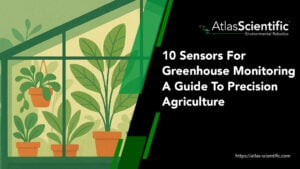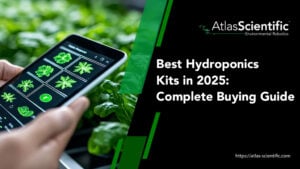

10 Sensors For Greenhouse Monitoring – A Guide To Precision Agriculture
Greenhouse monitoring is the backbone of precision agriculture, and it starts with the right sensors. The 10 most essential sensors to optimize crop health and
# Type at least 1 character to search # Hit enter to search or ESC to close

No products in the cart.

No products in the cart.
Product Categories

The Atlas Scientific line of EZO Complete circuits makes building a custom monitoring system easy, but if you don’t calibrate your sensors, then what good are your readings; And can you trust them?
The accuracy of your readings is directly related to the quality of your calibration.
Calibration is not difficult, and a little bit of care goes a long way.
In this tutorial we’ll quickly go over how to properly calibrate the EZO-Complete TMP, using the 100% free Atlas Desktop software. (click here to download now) You will need the following:

To connect the EZO Complete-TMP to your PC you’re going to need to use a Micro USB cable. Connect this now and run the Atlas Desktop Monitoring software.
Next, connect your PT-1000 temperature probe to the EZO Complete-TMP via the SMA connector.
Looking at the Atlas Desktop Monitoring software, you should see a gray rectangle appear on the screen indicating that an EZO-RTD circuit is connected. Click on this gray rectangle to go to the Temperature screen.

Now that you are in the temperature reading screen, click on the gears icon located on the bottom left corner of the screen. This will take you to the temperature calibration screen.

Within this page you can calibrate your PT-1000 probe; You can also clear the calibration from the memory in case you make a mistake or have recently attached a new PT-1000 probe to your EZO Complete-TMP.
Since the boiling point of water is always 100 °C (depending on your current elevation) it’s the easiest way to calibrate almost any temperature probe. Place the probe within boiling or soon-to-be boiling water and watch the temperature readings gradually rise. After it hits 100 °C, wait for the readings to stabilize, then click on the calibrate button.

Congratulations! You have completed the calibration process and are now ready to take readings.
You can adjust the calibration point to a value higher or lower than 100 °C should you need. At a higher elevation, heated water reaches its boiling point more quickly, i.e. at a lower temperature.
Below are some suggested calibration points, depending on your current elevation.
| Elevation in meters | Boiling point °C |
| 305 | 98.9 |
| 229 | 99.2 |
| 152 | 99.5 |
| 76 | 99.7 |
| 0 | 100 |
| -76 | 100.3 |
| -152 | 100.5 |
Atlas Scientific recommends that calibration be done every 2 – 3 years.
If you need just a bit more guidance on how to calibrate the Atlas Scientific EZO-Complete TMP, you can follow along with the video below.

Greenhouse monitoring is the backbone of precision agriculture, and it starts with the right sensors. The 10 most essential sensors to optimize crop health and

Hydroponics has revolutionized the way people grow food, offering soil-free methods that deliver nutrients directly to plant roots in water-based systems. But success in hydroponics